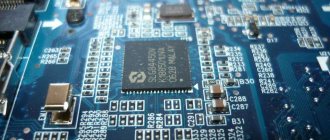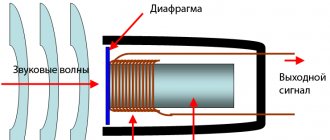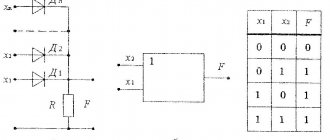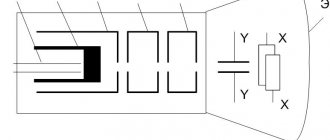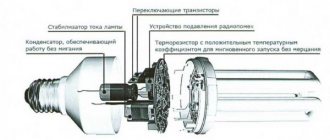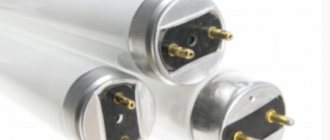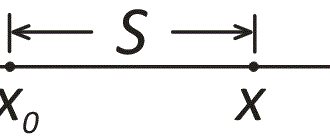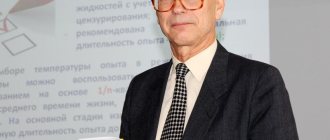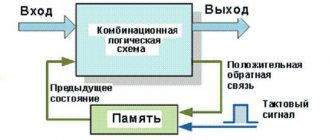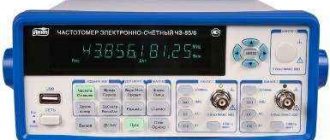"Pulses per second" redirects here. It should not be confused with the Pulse Per Second signal.
Pulse repetition rate
(
PRF
) is the number of pulses of a repeating signal in a specific unit of time, usually measured in
pulses per second
. The term is used in a number of engineering disciplines, particularly radar.
In a radar, a radio signal of a specific carrier frequency is turned on and off; the term frequency refers to the carrier, while PRF refers to the number of switches. Both are measured in cycles per second or hertz. The PRF is usually much lower than the frequency. For example, a typical World War II radar such as the Type 7 GCI radar had a base carrier frequency of 209 MHz (209 million cycles per second) and a pulse repetition rate of 300 or 500 pulses per second. A related measure is pulse width, the time the transmitter is on during each pulse.
PRF is one of the defining characteristics of a radar system, which typically consists of a high-power transmitter and a sensitive receiver connected to a single antenna. After creating a short pulse of radio signal, the transmitter is turned off so that receiving devices can hear the reflections of this signal from distant targets. Since the radio signal must travel to the target and back, the required silent period between pulses is a function of the desired radar range. Longer range signals require longer periods, requiring lower PRF values. Conversely, higher pulse repetition rates produce shorter maximum ranges, but transmit more pulses and therefore radio energy in a given time. This creates stronger reflections, making detection easier. Radar systems must balance these two competing requirements.
Using older electronics, PRFs were typically fixed at a specific value or could be switched between a limited set of possible values. This gives each radar system a characteristic PRF that can be used in electronic warfare to identify the type or class of a specific platform, such as a ship or aircraft, or in some cases, a specific unit. Aircraft radar warning receivers include a library of generic PRFs that can identify not only the radar type, but in some cases the mode of operation. This made it possible, for example, to warn pilots when the SA-2 air defense system battery was “blocked.” Modern radar systems can usually smoothly change their pulse repetition rate, pulse width, and carrier frequency, making identification much more difficult.
Sonar and lidar systems also have a pulse repetition rate, just like any pulse system. In the case of sonar, the more common term is pulse repetition rate
(
PRR
), although it refers to the same concept.
Introduction [edit]
Electromagnetic (e.g., radio or light) waves are conceptually pure single-frequency phenomena, while pulses can be represented mathematically as being composed of a number of pure frequencies that add up and cancel out in interactions that create a sequence of pulses of specific amplitudes, PRRs, base frequencies, phase characteristics, etc. (see Fourier analysis). The former term (PRF) is more commonly found in device technical literature (electrical engineering and some sciences), while the latter (PRR) is more commonly used in military aerospace terminology (especially US military terminology) and equipment specifications such as radar training and technical manuals. and sonar systems.
The reciprocal of PRF (or PRR) is called pulse repetition time
(
PRT
),
pulse repetition interval
(
PRI
), or
interpulse period
(
IPP
), which is the time elapsed from the start of one pulse to the start of the next pulse. The term IPP is commonly used to refer to the number of PRT periods to be digitally processed. Each PRT has a fixed number of range gates, but not all of them are used. For example, the APY-1 radar used 128 IPPs with a fixed 50 range gates, creating 128 Doppler filters using FFT. The different number of range gates on each of the five PRFs is less than 50.
In radar technology, PRF is important because it determines the maximum range to the target ( R
max) and maximum Doppler velocity (
Vmax
), which can be accurately determined by the radar. [1] Conversely, a high PRR/PRF can improve target recognition of closer objects such as a periscope or a fast-moving missile. This results in the use of low PRRs for search radars and very high PRFs for fire control radars. Many multi-mission and navigation radars, especially naval designs with variable PRRs, allow the experienced operator to adjust the PRR to improve and clarify the radar picture—for example, in poor sea conditions where wave action causes false returns, and in general to reduce clutter. or perhaps a better response signal from a prominent landscape feature (such as a cliff).
pulse duration
pulse duration The time interval between the initial moment of the voltage pulse and the moment the instantaneous voltage value is restored to the original or close to it level. [GOST 13109-97]
Topics
Related concepts
Useful
See what “pulse duration” is in other dictionaries:
duration (pulse) - The time interval between the first and last moments at which the instantaneous value of the pulse reaches 50% of its amplitude (ITU T K.43). [https://www.iks media.ru/glossary/index.html?glossid=2400324] Telecommunications topics, basic concepts EN... ... Technical Translator's Handbook
Pulse Width - 3.67 Pulse Width: The increment of time measured between the points corresponding to half the peak power at the beginning and end of the pulse. Source... Dictionary-reference book of terms of normative and technical documentation
duration (pulse) - 3.9 duration (pulse): The time interval between the moments when the instantaneous value of the impulse for the first and last time reaches 50% of the peak value of the impulse. Source... Dictionary-reference book of terms of normative and technical documentation
impulse duration - impulso trukmė statusas T sritis automatika atitikmenys: engl. pulse duration; pulse time; pulse width vok. Impulsdauer, f; Impulslänge, f; Pulsbreite, f rus. pulse duration, f; pulse width, f pranc. durée d impulse, f; largeur d… … Automatikos terminų žodynas
impulse duration - impulso trukmė statusas T sritis Standartizacija ir metrologija apibrėžtis Trukmė apibrėžtame impulso amplitudės lygyje. atitikmenys: engl. pulse duration vok. Impulsdauer, f; Impulslange, f rus. pulse duration, f pranc. durée d'impulsion … Penkiakalbis aiškinamasis metrologijos terminų žodynas
impulse duration - impulso trukmė statusas T sritis fizika atitikmenys: engl. pulse duration; pulse time vok. Impulsdauer, f rus. pulse duration, f pranc. durée d'impulsion, f … Fizikos terminų žodynas
pulse duration td, s - 3.48 pulse duration td, s: 1.25th part of the time interval between moments when the time integral of the square of the instantaneous acoustic value reaches the 0.1th and 0.9th parts of its final value. (See Figure 2.)… …Dictionary-reference book of terms of normative and technical documentation
pulse duration - pulse width ... Dictionary of Russian synonyms for automatic control technologies
Pulse duration - 1. The time interval during which the radiation strength of the semiconductor emitter is greater than or equal to half of its maximum value. Used in the document: GOST 27299 87 Semiconductor optoelectronic devices. Terms, definitions and... ... Telecommunications Dictionary
Current pulse duration of the exchange switch is 110 Source: GOST 28111 89: Microassemblies on cylindrical magnetic domains. Terms and definitions original... Dictionary-reference book of terms of normative and technical documentation
Source
Definition[edit]
Pulse repetition rate (PRF) is the number of times pulse activity occurs each second.
This is similar to cycles per second used to describe other types of signals.
The pulse repetition rate is inversely proportional to the time period, which is a property of the pulse wave. T {\displaystyle \mathrm {T} }
T = 1 PRF {\displaystyle \mathrm {T} ={\frac {1}{\text{PRF}}}}
PRF is usually associated with the interpulse interval, which is the distance a pulse travels before the next pulse appears.
Pulse Spacing = Propagation Speed PRF {\displaystyle {\text{Pulse Spacing}}={\frac {\text{Propagation Speed}}{\text{PRF}}}}
pulse duration
3.67 pulse duration:
The increment in time measured between the half-peak power points at the beginning and end of the pulse.
3.28 pulse duration
(pulse duration): The maximum time required to measure the two intersection points of a rising and falling pulse with a straight line drawn parallel to the x-axis at half the maximum value.
e and the instantaneous value of the fundamental frequency voltage corresponding to the moment the pulse begins. The time interval between the initial moment
See also related terms:
3.48 pulse duration t
d, c:
1.25th part of the time interval between the instants when the time integral of the square of the instantaneous acoustic value
reaches the 0.1th and 0.9th parts of its final value. (See Figure 2.)
93 pulse duration Δt
Imp:
The time interval from the beginning of the pulse to the moment when the pulse voltage decreases to half the maximum value of its amplitude
de. Ruckenhalbwertdauer einer Stoßspannung
en. Time to half value (of an impulse)
fr. Durée In mi-hauteur (d'une impulsion de tension)
47. Duration of the ignition pulse of a continuous gas discharge lamp
Ignition pulse duration
The time interval during which the ignition pulse voltage value of a continuous discharge lamp exceeds a specified level from the peak value
9. Duration of the radiation pulse of a semiconductor emitter
Radiation pulse duration
The time interval during which the radiation intensity of a semiconductor emitter is greater than or equal to half its maximum value
32. Laser pulse duration**
2. Anode reverse voltage pulse duration
Time interval during which reverse voltage is applied to the anode of the device
87 duration of the reference voltage pulse (sign-synthesizing indicator) during recording [erasing];
t.z [t.s]:
The time interval during which the value of the reference voltage pulse of the sign-synthesizing indicator exceeds 0.9 of the amplitude value when recording [erasing].
3. Anode current pulse duration
The time interval during which current flows through the device
107. Current pulse duration of the CMD generator
τg *
Generator current pulse duration
3. Duration of current or voltage pulse in closed state
4. Duration of current or voltage pulse in open state
5. Duration of current pulse or control voltage
Duration of the information exchange current pulse
Exchange switch current pulse duration
110. Current pulse duration of the exchange switch CMD
tob
Exchange switch current pulse duration
NDP. Duration of the information exchange current pulse
108. Current pulse duration of the CMD input switch
τвв
Input current pulse duration
109. Current pulse duration of the CMD output switch
tv
Output current pulse duration
111. Current pulse duration of the CMD replicator
τр
Replicator current pulse duration
Useful
See what “pulse duration” is in other dictionaries:
pulse duration - The time interval between the initial moment of the voltage pulse and the moment of restoration of the instantaneous voltage value to the original or close to it level. [GOST 13109 97] pulse duration 1. The time interval between the beginning and... ... Technical Translator's Reference
duration (pulse) - The time interval between the first and last moments at which the instantaneous value of the pulse reaches 50% of its amplitude (ITU T K.43). [https://www.iks media.ru/glossary/index.html?glossid=2400324] Telecommunications topics, basic concepts EN... ... Technical Translator's Handbook
duration (pulse) - 3.9 duration (pulse): The time interval between the moments when the instantaneous value of the impulse for the first and last time reaches 50% of the peak value of the impulse. Source... Dictionary-reference book of terms of normative and technical documentation
impulse duration - impulso trukmė statusas T sritis automatika atitikmenys: engl. pulse duration; pulse time; pulse width vok. Impulsdauer, f; Impulslänge, f; Pulsbreite, f rus. pulse duration, f; pulse width, f pranc. durée d impulse, f; largeur d… … Automatikos terminų žodynas
impulse duration - impulso trukmė statusas T sritis Standartizacija ir metrologija apibrėžtis Trukmė apibrėžtame impulso amplitudės lygyje. atitikmenys: engl. pulse duration vok. Impulsdauer, f; Impulslange, f rus. pulse duration, f pranc. durée d'impulsion … Penkiakalbis aiškinamasis metrologijos terminų žodynas
impulse duration - impulso trukmė statusas T sritis fizika atitikmenys: engl. pulse duration; pulse time vok. Impulsdauer, f rus. pulse duration, f pranc. durée d'impulsion, f … Fizikos terminų žodynas
pulse duration td, s - 3.48 pulse duration td, s: 1.25th part of the time interval between moments when the time integral of the square of the instantaneous acoustic value reaches the 0.1th and 0.9th parts of its final value. (See Figure 2.)… …Dictionary-reference book of terms of normative and technical documentation
pulse duration - pulse width ... Dictionary of Russian synonyms for automatic control technologies
Pulse duration - 1. The time interval during which the radiation strength of the semiconductor emitter is greater than or equal to half of its maximum value. Used in the document: GOST 27299 87 Semiconductor optoelectronic devices. Terms, definitions and... ... Telecommunications Dictionary
Current pulse duration of the exchange switch is 110 Source: GOST 28111 89: Microassemblies on cylindrical magnetic domains. Terms and definitions original... Dictionary-reference book of terms of normative and technical documentation
Source
Physics[edit]
PRF is critical for making measurements of certain physical phenomena.
For example, a tachometer may use a variable-repetition strobe light to measure rotational speed. The strobe PRF is adjusted upward from a low value until the rotating object appears stationary. The tachometer's PRF will match the speed of the rotating object.
Other types of measurements include distance using time delay for reflected pulse echoes from light, microwaves, and sound transmission.
Video
RS trigger
Coffee capsule Nescafe Dolce Gusto Cappuccino, 3 packs of 16 capsules
1305 ₽ More details
Coffee capsules Nescafe Dolce Gusto Cappuccino, 8 servings (16 capsules)
435 ₽ More details
Hi-Res players
Dimension[edit]
PRF is critical for systems and devices that measure distance.
- Radar
- Laser rangefinder
- Sonar
Different PRFs allow systems to perform very different functions.
A radar system uses a radio frequency electromagnetic signal reflected from a target to determine information about that target.
PRF is required for radar operation. This is the speed at which transmitter pulses are sent into the air or space.
Range uncertainty[edit]
A real target at 100 km or a second scan echo at a distance of 400 km.
The radar system determines the range through the time delay between the transmission and reception of the pulse according to the relationship:
Range = c τ 2 {\displaystyle {\text{Range}}={\frac {c\tau }{2}}}
For accurate ranging, a pulse must be transmitted and reflected before the next pulse is transmitted. This results in the maximum unambiguous range limit:
Max Range = c τ PRT 2 = c 2 PRF { τ PRT = 1 PRF {\displaystyle {\text{Max Range}}={\frac {c\tau _{\text{PRT}}}{2}}= {\frac {c}{2\,{\text{PRF}}}}\qquad {\begin{cases}\tau _{\text{PRT}}={\frac {1}{\text{PRF} }}\end{cases}}}
The maximum range also determines the range uncertainty for all detected targets. Due to the periodic nature of pulsed radar systems, it is not possible for some radar systems to determine the difference between targets separated by integer multiples of the maximum range using a single PRF. More complex radar systems avoid this problem by using multiple PRFs simultaneously on different frequencies or on the same frequency with a varying PRT.
A range ambiguity resolution process is used to determine the true range when the PRF exceeds this limit.
Low PRF[edit]
Systems using PRF below 3 kHz are considered low PRF because the direct range can be measured at least 50 km away. Radar systems using low PRF typically provide single digit ranges.
Unambiguous Doppler processing becomes increasingly challenging due to coherence limitations as the PRF drops below 3 kHz.
For example, an L-band radar with a pulse repetition rate of 500 Hz produces ambiguous speeds above 75 m/s (170 mph) while detecting a true range of up to 300 km. This combination is suitable for civil aircraft radars and weather radars.
300 km range = C 2 × 500 {\displaystyle {\text{300 km range}}={\frac {C}{2\times 500}}} 75 m/s velocity = 500 × C 2 × 10 9 {\ displaystyle {\text{75 m/s velocity}}={\frac {500\times C}{2\times 10^{9}}}}
Radars with low pulse repetition rates have reduced sensitivity in the presence of low-speed interference, which interferes with the detection of aircraft in the vicinity of the terrain. A moving target indicator is usually required for acceptable close-terrain performance, but it introduces radar jagged issues that add complexity to the receiver. Low pulse repetition rate radars designed to detect aircraft and spacecraft suffer greatly from weather conditions that cannot be compensated for by a moving target indicator.
Average PRF[edit]
Range and speed can be determined using the average pulse rate, but neither can be identified directly. The average pulse repetition rate is from 3 to 30 kHz, which corresponds to a radar range of 5 to 50 km. This is an ambiguous range that is much less than the maximum range. Range ambiguity resolution is used to determine the true range in medium pulse rate radar.
Medium pulse repetition rate is used with pulse Doppler radar, which is needed for surveillance/shooting down in military systems. Doppler radar returns are usually not ambiguous until the speed exceeds the speed of sound.
Determining the true range and speed requires a technique called ambiguity resolution. Doppler signals range from 1.5 kHz to 15 kHz, which is audible, so audio signals from medium pulse repetition rate radar systems can be used for passive target classification.
For example, an L-band radar system using a 10 kHz pulse repetition rate with a 3.3% duty cycle can detect a true range of up to 450 km (30*C/10,000 km/s). This is the instrumental range
.
Single digit speed is 1,500 m/s (3,300 mph). 450 km = C 0.033 × 2 × 10,000 {\displaystyle {\text{450 km}}={\frac {C}{0.033\times 2\times 10,000}}} 1,500 m/s = 10,000 × C 2 × 10 9 {\displaystyle {\text{1,500 m/s}}={\frac {10,000\times C}{2\times 10^{9}}}}
Single-digit speed of an L-band radar using pulse repetition rate 10 kHz would be 1500 m/s (3300 mph) (10000 x C/(2 x 10^9)). True speed can be found for objects moving at speeds less than 45,000 m/s if the bandpass filter passes the signal (1.500 / 0.033).
Medium pulse repetition rate has unique problems with radar jaggedness, requiring duplication of detection circuits.
High PRF[edit]
Systems using pulse repetition rates above 30 kHz operate more commonly known as intermittent continuous wave (ICW) radars because forward speed can be measured up to 4.5 km/s in L band, but range resolution becomes more difficult.
High pulse repetition rates are limited to systems requiring close operation, such as proximity fuses and law enforcement radar.
For example, if during the rest phase between transmit pulses 30 samples are taken using a 30 kHz PRF, then the true range can be determined to a maximum of 150 km using 1 microsecond samples (30 x C / 30,000 km/s). Reflectors outside this range can be detected, but the true range cannot be identified.
150 km = 30 × C 2 × 30,000 {\displaystyle {\text{150 km}}={\frac {30\times C}{2\times 30,000}}} 4,500 m/s = 30,000 × C 2 × 10 9 {\displaystyle {\text{4,500 m/s}}={\frac {30,000\times C}{2\times 10^{9}}}}
It becomes increasingly difficult to take multiple samples between transmit pulses at these pulse frequencies, so range measurements are limited to short distances. [2]
Sonar [edit]
Sonars operate in the same way as radar, except that the medium is liquid or air and the signal frequency is sound or ultrasonic. Like radar, lower frequencies propagate relatively higher energies over longer distances with less resolution. Higher frequencies, which decay faster, provide increased resolution of nearby objects.
Signals travel at the speed of sound in a medium (almost always water), and the maximum pulse repetition rate depends on the size of the object being examined. For example, the speed of sound in water is 1497 m/s and the thickness of the human body is about 0.5 m, so the pulse repetition rate for ultrasound images of the human body should be less than about 2 kHz (1497 / 0.5).
Another example: the ocean is approximately 2 km deep, so sound returns from the seabed in a second. For this reason, sonar is a very slow technology with a very low PRF.
Laser [edit]
Main article: lidar
Light waves can be used as radar frequencies, in which case the system is known as lidar. It is short for "LIght Detection And Ranging", similar to the original meaning of the initialism "RADAR", which was RAdio Detection And Ranging. Both words have since become widely used English words and are therefore abbreviations rather than initialisms.
Laser rangefinders or other light signal rangefinders operate in the same way as radar, at much higher frequencies. Non-laser light detection is widely used in automated machine control systems (e.g. electric eyes operating garage doors, conveyor sorting gates, etc. radar - without the bells and whistles of a human interface.
Unlike lower-frequency radio signals, light does not bend around the curve of the Earth or reflect off the ionosphere like C-band search radar signals, and therefore lidar is only useful in line-of-sight applications such as high-frequency radar systems.
Pulse Characteristics
Pulse shape
An important characteristic of pulses is their shape, which can be visually observed, for example, on the screen of an oscilloscope. In the general case, the shape of the pulses has the following components: front - the initial rise, a relatively flat top (not for all shapes) and cut (fall) - the final drop in voltage. There are several types of pulses of standard shapes that have a relatively simple mathematical description; such pulses are widely used in technology
In addition to pulses of a standard, simple shape, sometimes, in special cases, pulses of a special shape, described by a complex function, are used; there are also complex pulses, the shape of which is largely random, for example, video signal pulses.
Pulse parameters
In the general case, pulses are characterized by two main parameters - amplitude (peak-to-peak) and duration (denoted by τ
or
ti)
. The duration of sawtooth and triangular pulses is determined by the base (from the beginning of the voltage change to the end), for other types of pulses the duration is usually taken at a voltage level of 50% of the amplitude, for bell pulses a level of 10% is sometimes used, the duration of artificially synthesized bell pulses (with a clearly defined base) and half-waves of a sine wave are often measured at the base.
For different types of pulses, there are additional parameters that clarify the shape or characterize the degree of its imperfection. For example, to describe the non-ideality of rectangular pulses, parameters such as the duration of the rise and fall (ideally should tend to zero), the unevenness of the top, as well as the size of voltage surges after the rise and fall that arise as a result of parasitic processes are used.
Spectral representation of pulses
In addition to the temporal representation of pulses observed on an oscilloscope, there is a spectral representation expressed in the form of two functions - the amplitude and phase spectrum.
The spectrum of a single pulse is continuous and infinite. The amplitude spectrum of a rectangular pulse has clearly defined minima on the frequency scale, following at intervals reciprocal to the pulse duration.
Newton's second law in momentum form
Newton's second law states that the acceleration of a body is directly proportional to the force acting on it. It is written like this:
But acceleration is determined by the ratio of the difference between the final and initial speeds to the time during which the speed changed:
Let's substitute this expression into Newton's second law and get:
F ∆t - force impulse, ∆ p - change in body momentum
Example No. 4. A body moves in a straight line in one direction. Under the influence of a constant force, in 3 s the momentum of the body changed by 6 kg∙m/s. What is the modulus of force?
From the force impulse formula we express the force modulus:
Law of conservation of momentum in projection onto the horizontal axis
If before and after the collision the velocities of the bodies are directed along the horizontal axis, then the law of conservation of momentum should be written in projections onto the OX axis. We must not forget that the vector projection sign:
In an inelastic collision of two bodies moving towards each other, the speed of the joint motion will be directed in the direction where the body with high momentum was moving before the collision.
Special cases of the law of conservation of momentum (in projections onto the horizontal axis)
| Inelastic collision with a stationary body | m1v1 = (m1 + m2)v |
| Inelastic collision of moving bodies | ± m1v1 ± m2v2 = ±(m1 + m2)v |
| At the initial moment the system of bodies is motionless | 0 = m1v'1 – m2v'2 |
| Before the interaction, the bodies moved at the same speed | (m1 + m2)v = ± m1v'1 ± m2v'2 |
Relative momentum
Relative momentum is a vector physical quantity equal to the product of body mass and relative speed:
p 1rel2 is the momentum of the first body relative to the second, m1 is the mass of the first body, v 1rel2 is the velocity of the first body relative to the second, v 1and v2 are the velocities of the first and second bodies, respectively, in the same reference frame.
Example No. 2. Two cars of the same mass (15 tons) are driving behind each other along the same straight line. The first - with a speed of 20 m/s, the second - with a speed of 15 m/s relative to the Earth. Calculate the momentum of the first car in the frame of reference associated with the second car.
First, let's convert the units of measurement to SI:
